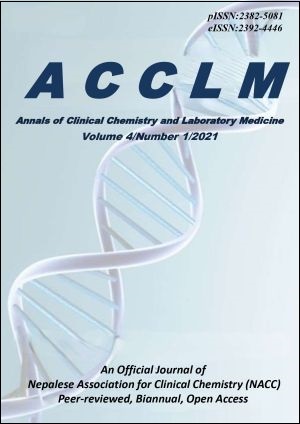Pathological changes in placentas of pregnant females with Gestational hypertension
DOI:
https://doi.org/10.3126/acclm.v4i1.42677Keywords:
Eclampsia, Placental Changes, Pregnancy, induced hypertension, pre-eclampsiaAbstract
Background: Hypertensive disorders complicating pregnancy are common and contribute greatly to maternal and fetal morbidity and mortality. The complications of hyper-tensive disorders in pregnancy have been attributed to abnormalities in the placenta. This study aims to observe the clinical, gross and microscopical (morphology) effects of pregnancy induced hypertension, preeclampsia and Eclampsia.
Methods: It was a prospective study conducted in 30 placentas of hypertensive disorder of pregnancy and 20 placentas of normal pregnancy. The placentas with hypertensive disorders of pregnancy were compared with the placentas of normal pregnancy.
Results: The mean age of mother at delivery was 28.1 years, 25.04 years and 25.04 years in pregnancy induced hypertension, preeclampsia and normal pregnancy respectively. The mean birth weight of new born babies, the mean placental weight and volume were found to be much lower than the control group. The risk for prematurity along with gross and histological abnormalities such as the presence of necrosis, villous hypermaturity, lymphohistiocytic villitis, avascular villi, perivillous fibrin deposits, hyalinization, stromal fibrosis, calcification and vessel wall thickening were observed significantly more often in the placentas of hypertensive mothers.
Conclusion: There is a significant Gross and microscopic changes observed in placentas of hypertensive mothers than the normal mothers. Similarly placental weight and volume were found to be much lower.
Downloads
Downloads
Published
How to Cite
Issue
Section
License
Copyright (c) 2021 Nepalese Association for Clinical Chemistry

This work is licensed under a Creative Commons Attribution-ShareAlike 4.0 International License.
Authors who publish with this journal agree to the following terms:
- The author transfers copyright to the Nepalese Association for Clinical Chemistry.
- The journal publishes the work under a Creative Commons Attribution License that allows others to share the work with an acknowledgement of the work's authorship and initial publication in this journal and under the same share-alike license used here.
- Authors are able to enter into separate, additional contractual arrangements for the non-exclusive distribution of the journal's published version of the work (e.g., post it to an institutional repository or publish it in a book), with an acknowledgement of its initial publication in this journal.
- Authors are permitted and encouraged to post their work online (e.g., in institutional repositories or on their website) prior to and during the submission process, as it can lead to productive exchanges, as well as earlier and greater citation of published work (See The Effect of Open Access).




